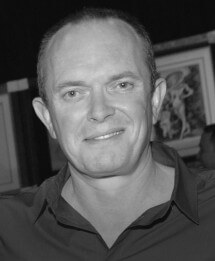Peter Nixon was born in Lytham St. Annes in the county of Lancashire, England in 1956. As a child, Peter was always artistic. He began drawing when he was 5 years old and went to a museum for the first time when he was 9 (The Royal Academy of Art in London) where he experienced Leonardo’s “Virgin and St. Anne” and “Virgin and Child.” These drawings had a profound effect on Peter’s artistic development.
At 17, Peter took a foundation course at Blackpool College of Art and Design, sharpening his interest in the human figure. His drawing skills improved with the help of multiple draughtsman tutors and the college helped him transform his interest into a passion. He completed his artistic education at Bath Academy of Art, discovering that his work had been lacking movement and energy thus far – uncovered while auditing dance courses and studying the figures and poses of the dancers. The human form coupled with Constructive Cubism fused to spark new branches of Peter’s style, amalgamating into a powerful artistic experience. Although many of his student peers were painting darker and more somberly, he realized that it was much harder to paint something happy – like falling in love – and he wanted to challenge himself.
When he’s in the studio, Peter drifts off, in very high spirits. He says that he’s mostly unaware of what he’s doing and makes his decisions instinctively. He sees things that he feels compelled to correct on his canvases and he makes his changes intuitively to resolve them. His studio is at the top of his home in London, 42 steps up. The artist jokes that he gets his exercise by perpetually forgetting things at the bottom of the stairs, forcing him to run up and down all day. Filled with books, pictures, and music, he calls his studio his haven. It overlooks a leafy park in the center of London and feels very intimate. London itself is a great source of inspiration for Peter, brimming with history, culture and art galleries that constantly juxtapose ancient and modern elements. While he occasionally thinks about leaving for the countryside, he says there’s no way he could leave everything the city offers behind.
Inspirations like these have helped the artist develop his style. Most recently, Peter has looked back on the first time he saw Leonardo’s drawings and was inspired to recreate a style based on his “sfumato” or smoky composition. His lines became softer and murkier, lost in the haze. This style builds on a fleeting sense of chronology, modeled after the “carta una” or first sheet of the Renaissance masters sketching in preparation of their frescos.
Earlier in his career, Peter spent time working for an etcher. Incredibly interested in texture, he wanted to translate this idea to his painting. He traveled to Venice, examining Titian, Veronese, and Bellini. The textures and costumes of each canvas were very ornate to him, translating into his appreciation for the achievements of civilization and the production of mankind.
His images speak of peace, harmony, and celebration. His approach is innovative in his use of classic methods in contemporary contexts. When he draws a line, he wants it to look natural, as if it flows straight through the page – second nature. Coming from years of practice, Peter compares his drawing technique to the swing of a golfer. He tries to draw with ease to keep the flow and balance.
Peter claims inspiration from almost everything, especially music. If he wasn’t an artist, he declared he’d like to be a jazz pianist. “Everything goes into the soup,” he says. The dynamism and movement of the human figure is something he tries to portray. He explains that humans don’t sit still and he’s trying to capture that energy in his work. He draws inspiration from the Renaissance master paintings in Venice, dance troupes, poetry, music, and gardens. He’s particularly inspired by Picasso, Titian, Bellini, and Veronese, as well as Matisse.
He also enjoys taking note of what his friends, family, and collectors have to say about his art. He explains that while he’s painting, he’s only concerned with the technical aspects of his work. Although he has his own feelings about his paintings, he doesn’t preconceive how his work will make others feel. Hearing about emotional reactions to his art is always surprising and much appreciated though.
These surprise reactions are a large part of why he enjoys working with Park West so much. Having the opportunity to meet his collectors and hear their feedback is very important to him. Having the creative freedom to paint what he desires, coupled with traveling the world alongside the other artists, has made this his dream job. Today Peter is widely exhibited in cities all over the world.
To learn more about the Peter Nixon Collection at Park West Gallery, please visit Nixon’s artist website.




